Centerpin Fishing: FULL ARTICLE
I would argue with anyone that Centerpin fishing is the most effective way to catch trout, steelhead, and salmon, and it’s a lot of fun. The reason I say this with confidence is because I’ve been guiding with centerpin reels, spinning reels, and baitcasting reels for over 22 years, so I know which one is best for float fishing.
If you want to know all about Centerpin fishing and you want to learn the tips and tactics used by expert guides, you’ve come to the right place.
I have taught thousands of anglers how to centerpin. The tactics and methods I use can significantly increase the amount of fish you catch. If you don’t fish the same way guide do, you’re probably missing a lot of fish.
But before you read any further, this is the shortened and revised article. The full article covers everything in-depth with twice as much information and tips. See the full article HERE.
After Centerpin fishing for over 30 years, and as one of the top Centerpin guides in my area,
It uses a unique reel called a centerpin reel combined with an extra-long rod between 11 and 14 feet which allows anglers to present a bait under a float with extreme precision.
Although Centerpin fishing can be the most effective method, I can tell you from 33 years of experience that it’s only effective if you know how to do it well, and if your setup is correct.
As an expert in Centerpin fishing, I tell anglers that there are 4 key fundamentals that both new and experienced anglers need to know and get good at. I’ll share those with you here, because if you mess up even one of them (many anglers do) you will struggle to consistently catch fish.
These are the 4 key fundamentals to Centerpin fishing that you must know and do well.
- Setup: Your setup, which includes the rod and reel and how it’s set up, and especially your leader rig which must be done correct.
- Speed Control: Most anglers do not understand this concept well, but I believe it is the most critical part of catching fish.
- Covering The Water: As a guide and angler, I fish methodically and emphasize covering all potential spots within a spot so my clients don’t miss fish.
- Strike Zone: Finding the bottom is a skill all on its own and I have methods for doing this well.
I will discuss each of these, and I’ll give you two bonus fundamentals, and trust me, the sixth fundamental is extremely important.
Learning To Centerpin Or Just Improving?
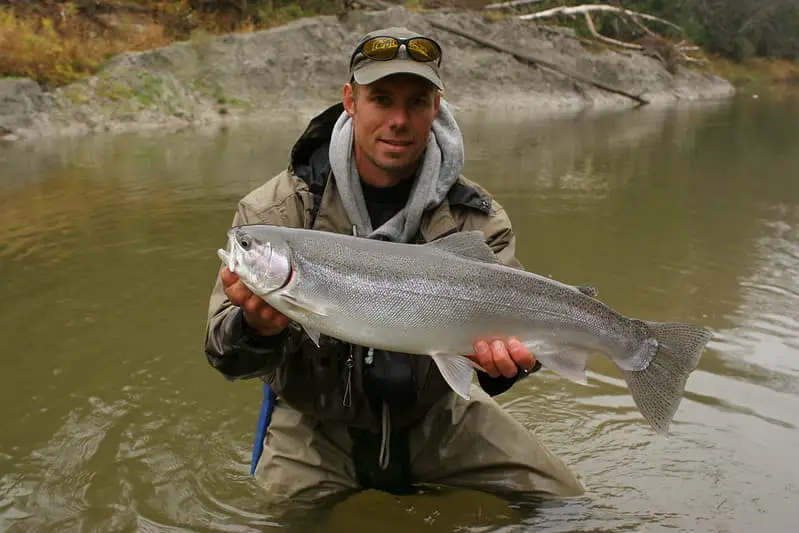
What makes me an expert on Centerpin fishing?
I started Centerpin fishing in 1988, which was long before most anglers had ever heard about this method.
In 2006, I started guiding and teaching anglers how to Centerpin fish, and I became the first full-time Centerpin fishing guide in my area. I may also be the first person in the world to ever offer Centerpin classes.
Since 2006, I’ve guided and taught over 1,000 new and experienced anglers and I have even taught other river guides how to Centerpin fish better. After teaching so many people I can assure you that catching fish with a Centerpin reel is not hard to learn, especially if you know and use my key fundamentals.
In fact, at one time, I even stopped fishing with the Centerpin for many years (except on icy cold days) because it was too easy to steelhead. At this time, I went back to the fly rod to give myself more of a challenge.
Keep reading and I’ll give you my tips and tactics and my step-by-step process to help you catch more fish with a Centerpin Rod and Reel.
What Is Centerpin Fishing?
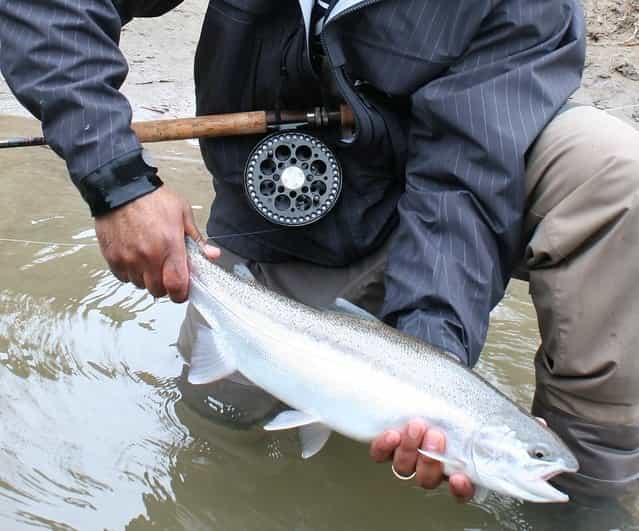
Centerpin fishing is a popular method that uses a float to suspend and present a bait to fish in rivers, which is why it’s also known as float fishing. It is float fishing, except it’s just with a Centerpin reel instead of a spinning reel or a baitcasting reel.
Centerpin fishing is used in the Great Lakes region and on the West Coast for steelhead, salmon, and trout.
History And Origins Of Centerpin Fishing History
Centerpin fishing is rumored to have actually started in the UK or Europe where carp anglers fishing lakes, lochs, and rivers designed a round reel with no drag so that the current or even the wind would allow their bait to move freely through the water once they set their rod down and waited for a bite.
Once the reel started to spin faster, they knew that a fish was on the line.
Centerpin Fishing In North America
The history of Centerpin fishing in North America is less clear. When I go out west and fish the Pacific Coast Rivers in the USA or Canada, they tell me Centerpin fishing originated there. But, when I fish in USA states like New York and Michigan, they tell me it started there.
However, after investigating when the first Centerpins started showing up in these areas, I realized that I and other anglers in my area had been fishing with Centerpin reels for steelhead and salmon almost 10 years earlier.
In the Great Lakes region, it is believed that the first anglers started fishing Centerpin reels for steelhead on Lake Ontario rivers on the Ontario, Canada side around the late 1970’s and early 1980s. This may have been where and when Centerpin reels started being used in North America. Now it seems like 8 out of 10 anglers in this area are using Centerpin reels.
Why Centerpin Fish?
The simple truth is that Centerpin reel allows you to get a much better presentation when float fishing than spinning reel or baitcasting reels which usually results in more fish.
The reason is the smooth high-end bearings that allow the float to easily pull line of the reel.
I have guided for trout, steelhead, and salmon with Centerpin reels, baitcasting reels, and spinning reels, and because I am proficient with all of them, I can honestly say that when it comes to drifting a bait under a float in a river, you can not beat the Centerpin reel.
The Centerpin Reel: The Reel With No Drag
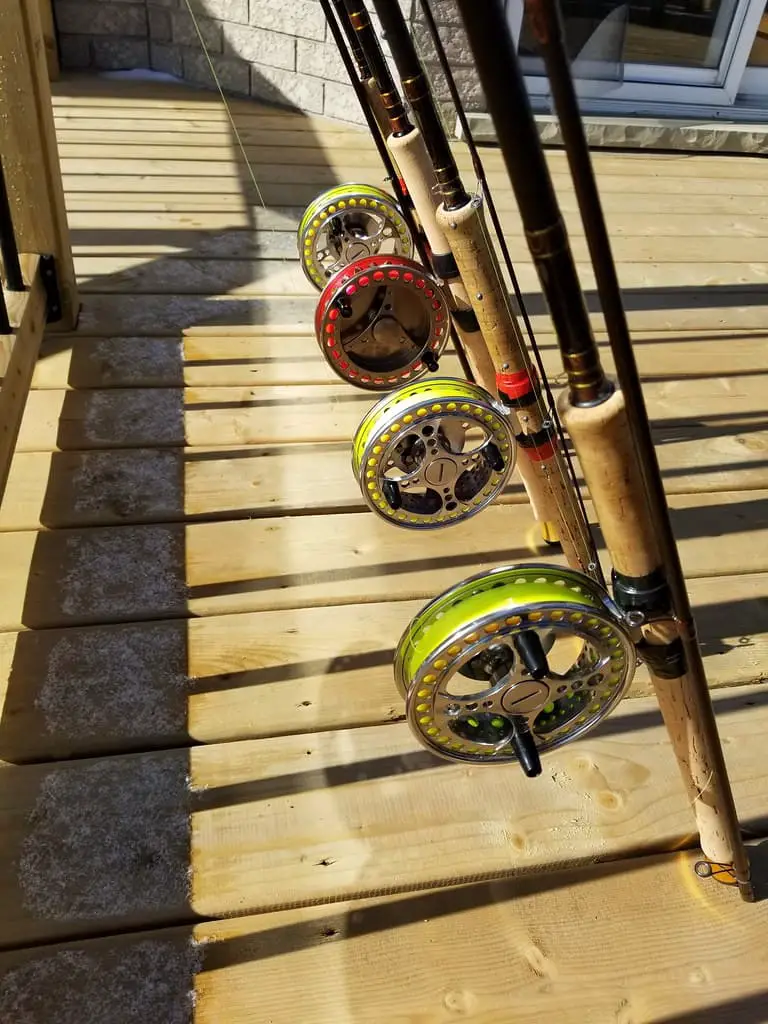
With a Centerpin reel, you can get a more controlled and smoother presentation, make much longer drifts, and have fewer line problems than with a spinning reel.
The Centerpin reel is a large rounded spool reel that is usually between 4″ and 5.5 inches in diameter, and the spool sits on a single pin (or post) in the middle of the base of the reel.
The spool uses very high-quality bearings that allow it to spin freely around the pin both backward and forwards, and there is normally no drag on a Centerpin reel.
Which Centerpin Reel Should You Buy?
There are many great Centerpin reels and some crappy ones too. I tell anglers to buy the best reel in their budget, and if possible avoid the cheap no-name reels. I discuss some of the best on my page “Best Centerpin Reels“.
How To Use A Centerpin Reel
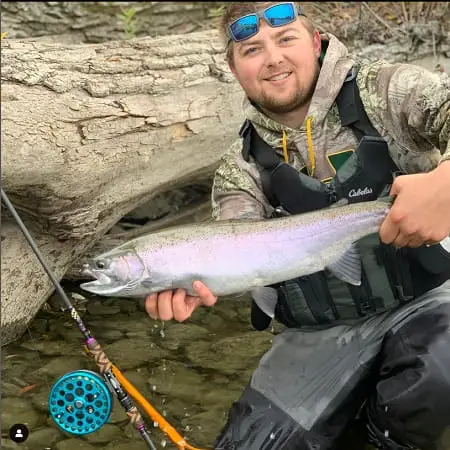
Centerpin reels allow the angler to free-spool the line off the reel which allows them to get long controlled drifts. Anglers can then use their fingers on the reel to control the speed of their float and their bait, which is critical to catching more fish.
This speed control and the smoothness of the line coming off the reel is the primary reason a Centerpin reel works better than a spinning reel when float fishing.
Anglers also use their hands to stop the reel, to set the hook, and as a drag when fighting the fish.
How To Set Up A Centerpin Reel Properly?
Setting up your reel properly and with the correct hand will ensure better success when Centerpin fishing.
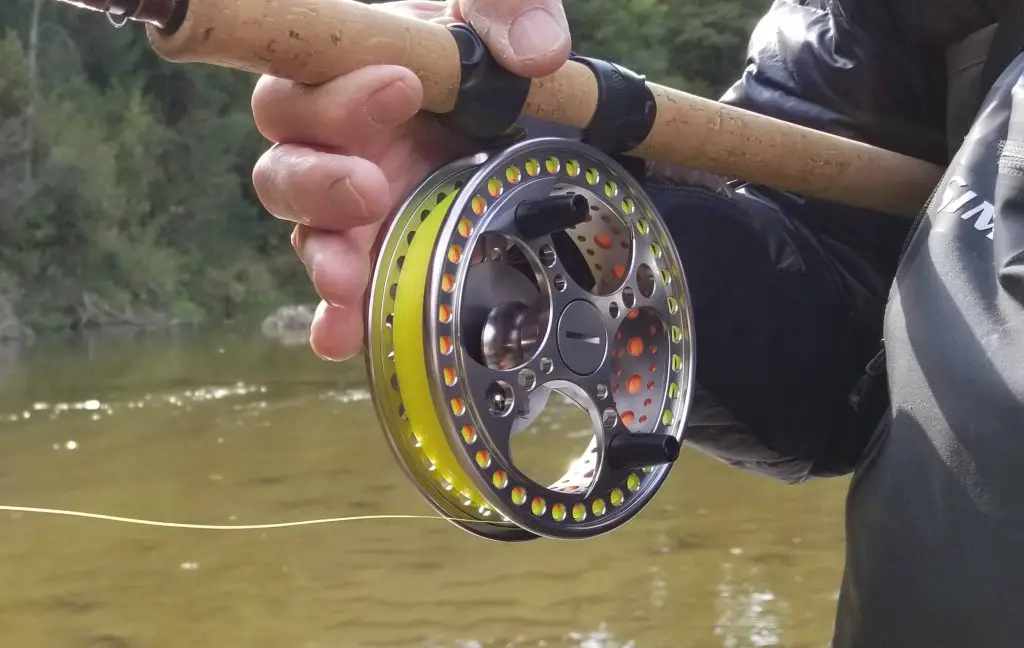
Left Hand or Right Hand – If you are going to do Centerpin fishing then you might as well start the right way.
Centerpin reels are made to go both forward and backward so you can use them for right-handed retrieve or left-handed retrieve without any adjustments or handle changes just by switch which side of the rod the handle go on.
The problem is that many guys use the wrong hand.
In a nutshell, if you are right-handed, you need to use your left hand to reel, and you MUST put the line on the right way for this hand. If you are left-handed you need to use a right-handed reel. There are many reasons why.
Centerpin Line
The line used for Centerpin reels is either a monofilament or braided line. It is crucial to use a recommended line.
Some lines are more buoyant and lightweight than others and these are the lines you want to use. These lines will make casting, line control, mending, and setting the hook much easier. I prefer the Raven Mainline which you can see on my page Best Lines For Float Fishing.
How To Put A Centerpin Reel On
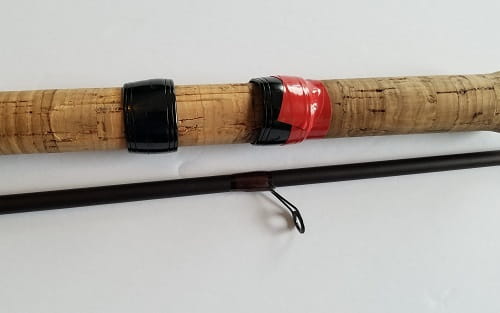
There are two types of rod handles, A fixed reel seat and a sliding rings real seat. Both have advantages and disadvantages.
I prefer a sliding rings reel seat which enables me to put the reel anywhere on the handle which can balance out the rod and reel, and can also aid in fishing and fighting fish.
But, not putting the reel on a sliding rings rod properly can lead to your reel falling off, or affecting your ability to hook and fight fish.
I discuss proper hand retrieve, and proper grip, as well as how to set up your Centerpin reel, and what lines to use on my page how to set up a Centerpin reel.
How To Hold A Centerpin Reel
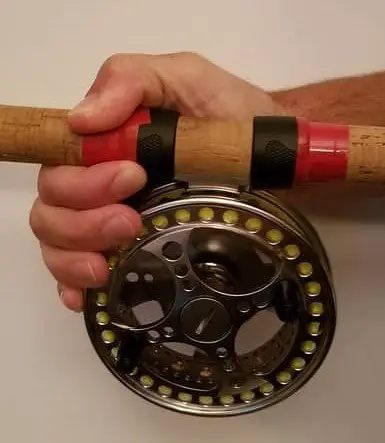
The Centerpin is a weird kid of reel on a very long rod, so some anglers wonder how to hold it.
You will be holding the reel all day, as well as casting, fighting some big fish with it, and also controlling the line as it comes out, which is why your grip on the Centerpin reel needs to be comfortable and functional.
The grip in the picture is the most common grip and is similar to what I use.
This grip allows the angler to have a good grip on the rod and on the reel while still being able to easily control the rim of the spool.
There are four things to consider when holding a Centerpin reel, comfort, casting, control of the spool, and fighting fish. I cover all of this and show you four ways to hold a Centerpin reel that work well, all on my page How To Hold A Centerpin Reel: 4 Ways That Work Well.
How To Cast A Centerpin Reel
There are five different casts that work when Centerpin fishing but I only teach 2 of them. I have witnessed anglers using the other ones with little success or with some difficulty.
All the top Centerpin anglers and the top Centerpin guides that I know use the Side Cast, or the Spinning Side Cast, or the Wallace Cast. Any of these three casts will work on most rivers up to 100 feet wide which is why I say these are the best cast to use when Centerpin fishing.
I cover these casts and even a 4th cast for those anglers that really struggle with casting all on my page How To Cast A Centerpin Reel: The 3 Best Casts.
The Centerpin Rod
Centerpin fishing requires a long and almost whippy rod for multiple reasons.
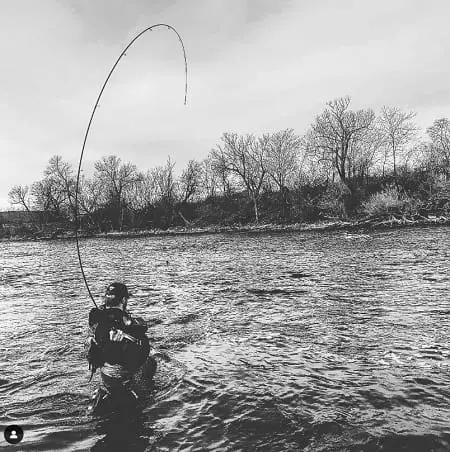
Most Centerpin rods are between 11 and 14 feet long. The benefit of a long Centerpin rod is that it allows you to keep the line off the water for longer, which improves your presentation.
The longer rod also acts like a giant shock absorber to protect your light leader when setting the hook and while playing the fish.
The type of river you fish will determine the best length of rod for you. The size of the fish will also determine the size or strength of the rod.
If you are planning on Centerpin fishing smaller rivers that are 10 to 20 feet wide or rivers with lots of trees and brush to walk through, a shorter 11-foot rod might be best for you.
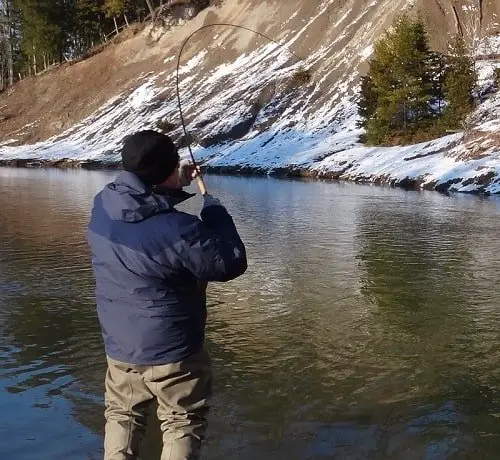
For Centerpin fishing on rivers that are from 20 to 60 feet wide or wider, a 13-foot Centerpin rod is best. When I am Centerpin fishing and when I am guiding, I use a 13-foot Centerpin rod for both small and large rivers. 13 feet long is a great all-around Centerpin rod length.
Some anglers will use longer Centerpin rods from 14 to 16 feet on very large rivers. Long rods give you more casting distance and line control.
Centerpin rods can range from $79.00 to over $1000 dollars. I will discuss everything you need to know about Centerpin rods on my page, 7 Best Centerpin Rods Of 2021.
Are Centerpin Combos Good?
I have searched the internet and have not found many pre-made Centerpin combos that I would recommend.
However, some stores may have put together good Centerpin combos, but before you go and buy one, checkout my page Centerpin Combo – 3 Best Centerpin Rod And Reel Combos
Gear For Centerpin Fishing – Everything You Need
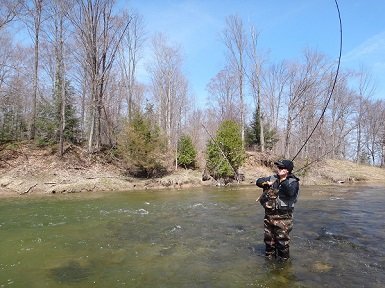
There are a bunch of things you will need for Centerpin fishing that I consider general river fishing gear.
Stuff like waders, boots, vests, packs, wading jackets, forceps, nippers, nets, and much more.
I will show you all the stuff that I use and recommend to my clients to keep me and them comfortable and fishing better on my page River Fishing Gear: Everything You Need To Succeed In 2021.
Centerpin Leader Set Up: A Critical Component
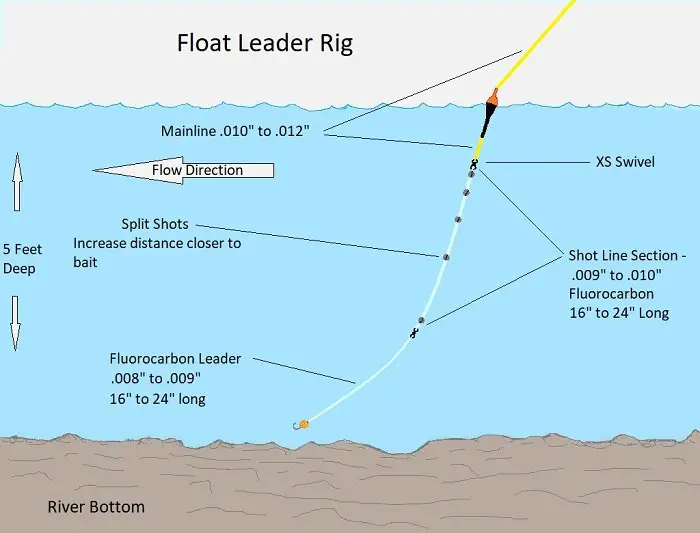
If you are reading this Centerpin Fishing for beginners page and are waiting for me to reveal the 4 fundamentals of Centerpin fishing, then this is number 4 on my list.
Using the right leader type, the correct size of leader line, and the right leader set-up is critical to catching fish.
Some years, my proven and effective leader setup, combined with the other 3 fundamentals, has put over 500 steelhead in the net for my clients.
Key Elements Of A Centerpin Rig
- The Float, AKA The Bobber: It’s important to use the right type of float. A good float does more than tell you when you have a bite.
- Overall Leader Length: Your leader length needs to be the right length for the spot you are fishing. Too long, and you will drag the bottom and get snagged up often. Too short and you won’t be in the strike zone.
- Shot Line and Weights: The shot line is a section of your leader where you add your weights. Your weights are called split shots, and you must use the correct type, and you need to put them on the line in the right pattern. See Best Floats and Best Weights.
- Leader Diameter and Strength: Steelhead are line shy. Using a leader too thick means fewer bites, and using a leader too thin means you will break off a lot of fish. Leader sizes depend on the fish and size of river, but generally 8 to 12 for steelhead, and 10 to 16 for salmon. See Leaders Sizes For Steelhead , Leaders Sizes For Salmon, and Leader Size For Trout.
- Hook: Your hook needs to be the correct size and shape. Use hooks guide use, and adjust the size of the hook to the size of the bait. A good octopus hook like the Gamakatsu or Raven Specien hook are what most guides are using. Size 2 to 10, but that depends on the fish and the bait.
- Swivels: I use Raven XS or XXS swivels.
If you want to know my proven leader setups, and how to set up your leader properly and avoid common mistakes, check out my page Steelhead Leaders: Best Float Leader And 2 Proven Setups.
Setting Up Your Centerpin Rig
Before you can set up the rod, you need a few things that you shouldn’t go without.
There is a lot more that I use so for a checklist of all the gear that I use just for Centerpin fishing, go to my page Centerpin Fishing Gear – Everything You Need For More Fish.
The Best Baits For Centerpin Fishing
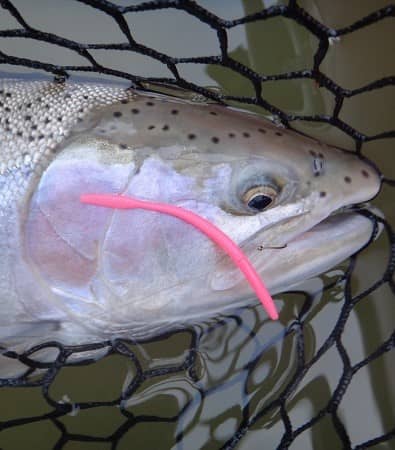
Believe it or not, I do not consider the bait as one of the 4 fundamental parts of the process for one simple reason.
The reason is that even if you have the best bait on your line but you don’t fish it properly you will still struggle to catch fish.
The most common bait is roe or spawn sacks. I do very well with plastic steelhead worms, beads, flies, and even tiny jigs.
So, if anything, I would say that your bait choice would be #5 on my list of most important things you need to know to be a successful Centerpin angler.
For more information on these baits, which ones I catch the most fish with, and how I fish them, go to my Best Steelhead Baits page.
Centerpin Fishing Through The Seasons
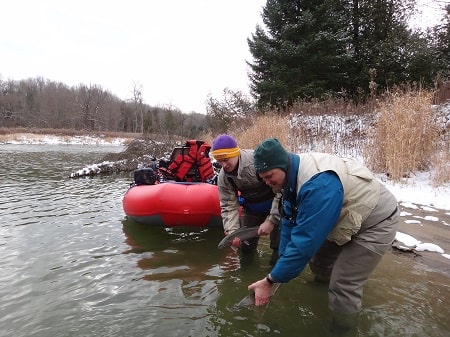
Centerpin fishing is an effective method for steelhead and trout 12 months of the year, and it can be great when the salmon are on the river.
It’s important that you know how to adapt to the changing conditions and know what baits work best and when, and where the steelhead will hold at different times of the year or you may struggle to catch fish.
Spring and fall steelhead fishing is often very different that fishing in the winter when fish are holding in deeper slower water and only feed at select times.
I’ve had to adapt to the changing river conditions to be sure that I keep my clients on fish even in the coldest weather and I tell you how I do this on my page Winter Fishing For Steelhead.
See Also:
Getting A Perfect Presentation
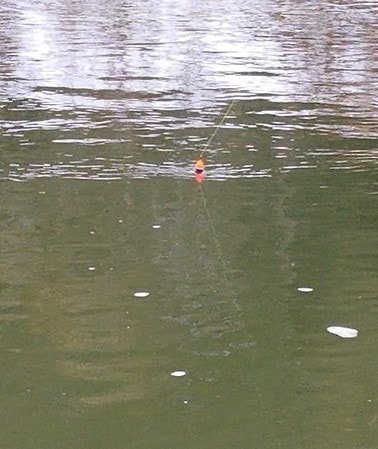
Presentation is the #1 thing you need to master, but there are different parts to your presentation that you need to know.
In fact, the Centerpin reel is better at providing a perfect presentation when float fishing than any other reel that I know of.
Presentation is so important that many times I have guided two clients and watched one of them present their bait perfectly and catch 5 to 10 fish while their buddy with a sloppy presentation catches none.
I have watched thousands of anglers fish and within seconds I can tell you if they will catch fish or not because of how they present their bait.
Bonus Guide Tip – Keep your rod tip steady so your float is not bouncing down the river. A bouncing float means a bouncing bait, and in my experience that makes many fish ignore your bait, it can also make it harder to detect a subtle bite.
Now let’s go over the top 3 fundamentals and some other tips I give to my clients and students.
#1 Speed Control Is Critical When Centerpin Fishing
Speed control is the #1 most critical thing that you can do to catch more fish, period! Speed control of your float and your bait is part of a great presentation and something you MUST learn.
Even if you master the other 3 fundamentals of great float fishing and you have a great bait on, if you get this one wrong, you will struggle to catch fish and I say this with confidence because I have watched thousands of anglers not catch fish when they should.
This is important when fishing for trout, steelhead, and salmon.
Most anglers just throw their float in and watch it go and then hope at some point, it will go down and a fish will be on the line. This is a big mistake.
Not working your float every second of the time during a drift dramatically limits your chances of catching a fish! I have proven this over, and over, and over again.
To slow your speed, you need to do something called trotting which you can easily do by controlling the speed of the line that is coming off the reel. You simply hold the line back just enough that your float tilts slightly upriver.
To learn more about this very critical part of float fishing check out my page Controlling Your Speed For More Fish When Float Fishing.
#2 Strike Zone: Finding The Bottom When Centerpin Fishing
Finding the bottom is the number #2 fundamental of good Centerpin fishing.
Finding the bottom is so important that when I teach anglers to Centerpin fish I often tell them that whenever they fish a new spot, the primary goal is to find the bottom.
You need to find the bottom every time because that is where the fish are mostly holding and feeding!
If they are down 9 feet and your bait is 3 feet over their heads, they probably won’t eat it. Anglers make this mistake all the time, and finding the bottom with just your bait can be a bit tricky.
You can find the bottom by using a really good sensitive float and my two simple methods for finding the bottom with that float.
To learn how to do this well and to see the two methods that I use to find the bottom and get my bait just off the bottom check out my page How To Know How Deep To Set Your Float – 2 Easy Ways
#3 Covering The Water Effectively When Centerpin Fishing
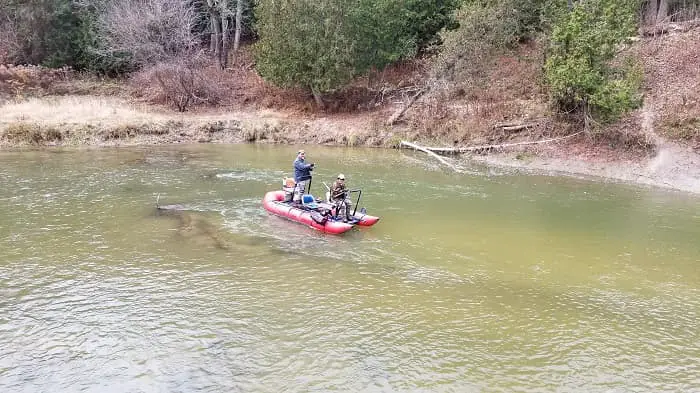
Covering the water effectively is the #3 fundamental for great float fishing and one that you need to do well if you want to catch more fish.
I fish in lines up and down the river from the closest part of the run to the furthest part of the run.
The problem is that most anglers just cast their floats out and often cover the same water over and over again and they don’t cover all of the water very well. Most anglers miss a lot of good water that fish can be sitting in.
To cover the water effectively, you need to stand near the top of the spot about 1 and a half rods length from where the deep water starts. Then cast your float at the edge of the deep water and fish as far down as you can. Then cast about 1 foot further across and repeat this until you have completely covered all the deeper water without missing any of it.
To see this in more detail, visit my page Effectively Covering The Water When Float Fishing.
Fish From The Top Down
With Centerpin fishing, you are drifting your float down the river. To control your speed effectively and to get a better presentation you MUST be upriver of your float.
Casting upriver will not allow you to get a proper leader angle, will not allow you to control your speed, and could give you a poor hookset due to slack coming into the line.
When you start fishing a new spot, get as far up the pool as you can and cast straight out, not upriver and not straight downriver, just straight out toward the far bank and work your float down the river from there.
Being at the top of the spot is the start of covering the water like a pro.
How To Set The Hook With A Centerpin
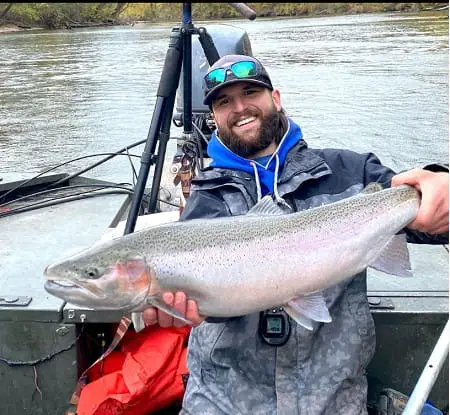
You might be thinking I don’t need to read about how to set the hook, but the reality is that setting the hook with a 13-foot rod and a Centerpin reel is a lot different than setting the hook with your 7-foot bass rod.
I’ve been hit by flying floats and leaders because guys set too hard, and I’ve seen anglers lose fish after fish because they set the hook too soft or too slow.
Many anglers set to slow which results in missed fish, so it is imperative to set the hook the second your float drops.
Set the hook only hard enough that the float “pops” on the water. If you set the hoos so hard your float and leader come flying back at you you’re setting too hard and you’re following through with your elbow.
I discuss setting the hook better on my page How To Set The Hook When Float Fishing.
How To Fight A Fish With A Centerpin
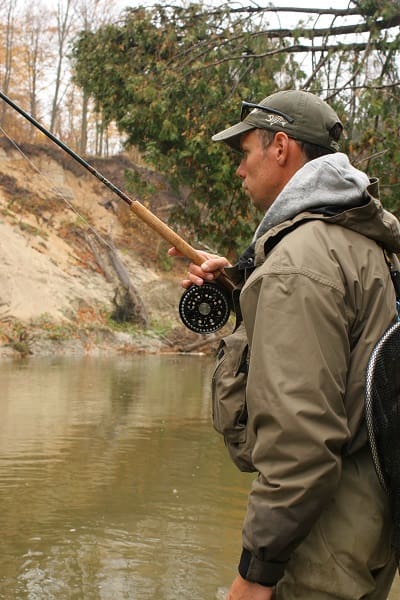
I tell all my clients that I believe 90% of anglers will lose their first good fish on a Centerpin Reel.
There is no drag on most Centerpin reels so it’s you and the fish playing tug of war, it’s a give and take battle.
The simple truth is that new Centerpin anglers either give the fish too much line with not enough pressure on the reel and eventually they lose them after a long fight, or they clamp down too much and then break the fish off.
Most new Centerpin anglers struggle with applying steady, even, and maximum pressure on the fish.
One second it’s too much pressure and the next it’s too little. This will take some time to get used to, but steady smooth pressure is a must. If one second you’re too loose and then you apply too much pressure to compensate you’re going to break off.
You also have to learn to let them run. If they bolt you lower your rod and apply steady pressure and as soon as they stop you take your fingers off the fighting rim and reel them in
Always maintain a tight line and a bend in the rod. Good Luck.
How To Land A Fish With A Centerpin
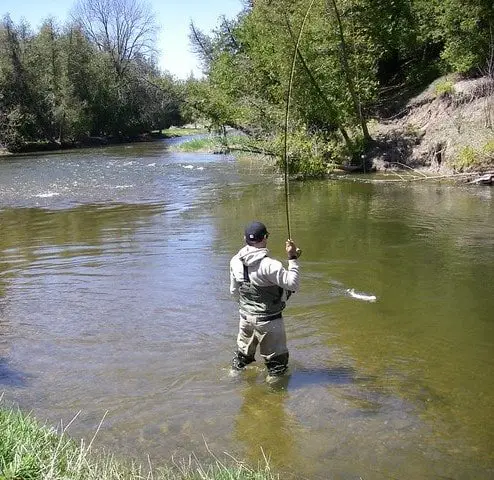
One of the things I see new anglers do wrong when they are about to land a fish is that they reel the fish almost to the tip of the rod.
That tip is 13 feet away on the long rod which means the fish is going to be too far for the net.
Always leave just over a rod’s length of the line from the tip to the fish and that fish should come right to the net.
And always use a net. Not only does a net help you net that fish of a lifetime, but studies show that fish bashing their head off the bank can kill them after you release them, even if they swim away looking fine. For the best Steelhead nets for the river check out my page Steelhead Net: 5 Best Steelhead Nets For River Fishing.
How To Take Care Of Your Centerpin
Most of my Centerpin reels run perfectly for over 10 years with no maintenance.
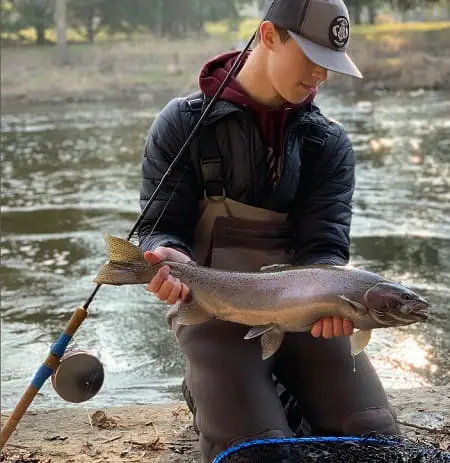
My best advice for taking good care of your new and shiny Centerpin reel is simple.
Don’t drop it, don’t lie it down on the rocks or in the mud or on the sand, and never put it in the river.
Lean your rod and reel instead of lying it flat on the ground.
If it rains on it that’s OK, and a little river water is fine every now and then, but remember that there are specs of dirt and sand in the river that can cause problems so avoid putting it in the river if you want it to last for 10 years with no maintenance.
Almost every person that has come into my tackle store needing new bearings was one of those guys that lie the rod down in the water as they handle and release their fish.
Yes, the reel on the rocks beside the fish looks great in a picture, but it’s risky, especially if the fish flops and hits the reel which could damage the reel.
Also, to extend the life and look of your Centerpin reel, when traveling, I highly recommend getting a Centerpin reel case for it.
Guide Tip: It is very important not to bang your reel or drop it. Doing so may damage the outer fighting rim which you will feel constantly when fighting a fish and it may even hurt your fingers. Damaging that rim usually means replacing the rim or the whole reel.
Centerpin Fishing For Beginners Education
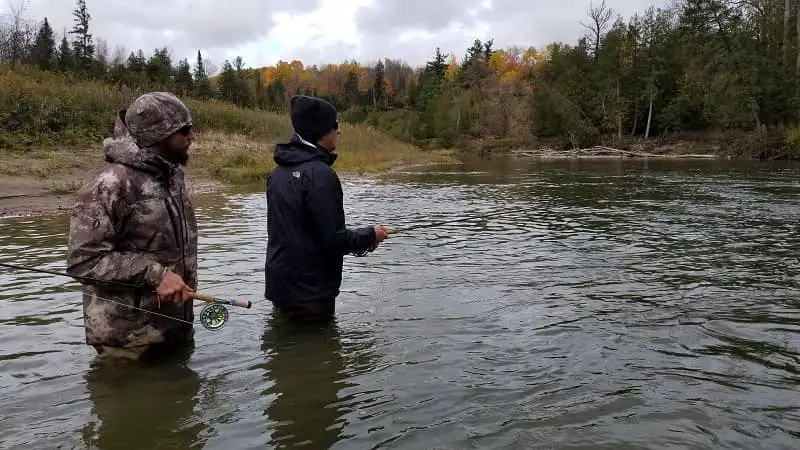
I highly recommend seeking out the Best Centerpin Fishing Guide in your area to help you improve your success with a Centerpin Rod and reel.
If the guide is good you should be able to learn more in one day than you could in years of trying yourself.
A good guide is not in everyone’s budget, so another great idea is to find a mentor, not just any old Centerpin guy, but one who is already skilled, uses and is good at the 4 fundamentals of Centerpin fishing, and can teach.
I honestly believe 7 out of 10 Centerpin anglers do it poorly and I have proven this over and over again so be careful who you learn from.
Another option is to be observant and open-minded. Try to find that one guy that catches 10 fish when everyone else is only catching one or two and don’t be like everyone else that believes he must just have the best bait. Look at how he sets up his leader, how he makes his drifts, how he adjusts his float, and how is he covering the water.
If you know someone that struggles to catch fish when float fishing, be a good friend and help me and them out by sharing this website with them too.
Summary Of The 4 Fundamentals: Plus Bonus
Here they are in order of importance:
#1. Presentation / Speed Control: Your presentation is the most important thing if you want To catch more steelhead, but, you need to recognize that speed control of your bait is the most important part of that presentation.
#2. Finding The Bottom: It won’t matter if you have a great presentation, and the best bait, and the best setup if you are presenting your bait out of the strike zone. For many fish like pacific salmon and steelhead, and for big trout, their strike zone is often 12 to 24 inches off the bottom and this is where your bait needs to be. Learning how to find the bottom can be critical.
#3. Covering The Water: Covering the water is essential to catching more steelhead, salmon, and trout when Centerpin fishing. Covering the water to me means putting the bait in every area of a spot where a fish might be holding and not missing a spot. I use a systematic approach that helps me land more fish.
#4. Setup: Your setup is number four of my top four fundamentals, and this is an easy one if you use a proven setup like the ones I show you on this website. You need to adjust that setup based on the conditions of the river, fish, or spot that you want to fish.
#5 Bait Selection: The bait you use is very important, especially if you doing the other four fundamentals well but bait selection, meaning how you choose your bait based on the conditions and what the fish wants is very important.
Don’t get stuck using the same bait all the time and learn to rotate baits to see if there is something the fish wants more.
BONUS: #6 Fundamental: DO IT ALL TOGETHER: This is equally important to understand. If you have a great presentation and great speed control but your setup is wrong, YOU WILL STRUGGLE!!
If your setup is perfect and you have the best bait on, which is always the case with my clients, but your speed control or presentation is off, YOU WILL STRUGGLE!!
If you have a great bait, a great setup, and a great presentation, but you cover the water poorly, you will miss fish and YOU WILL STRUGGLE!!
You must be at least somewhat good at each of the 4 fundamentals and then do them all well simultaneously if you ever want to catch fish like the top 10% of anglers do.. It’s as simple as that!!
Got A Question About Centerpin Fishing For Beginners
If you have a question, a tip, or a comment about Centerpin fishing for beginners, let me and the other readers know in the comment section below.
Tight Lines,
Graham

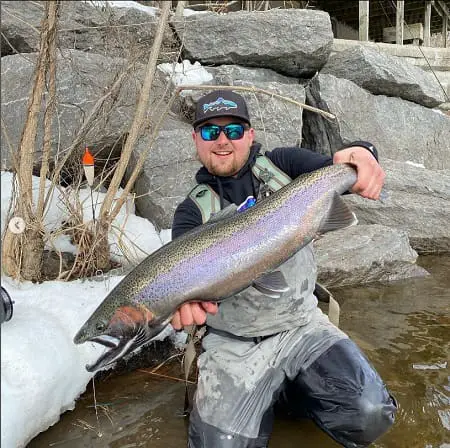
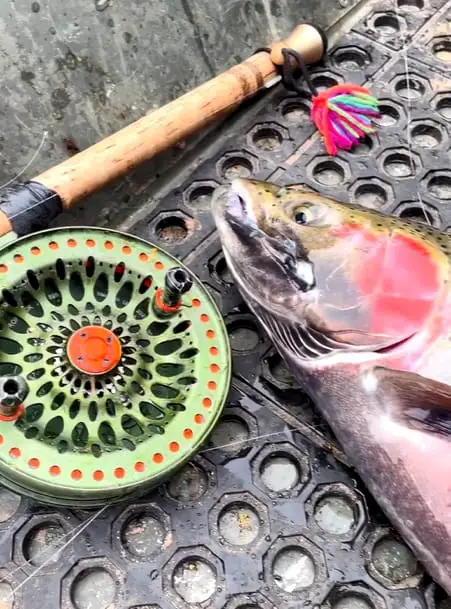
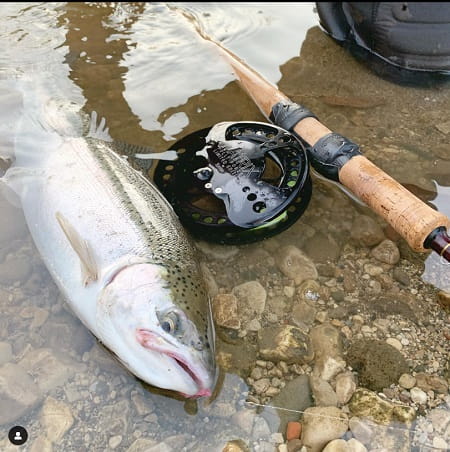
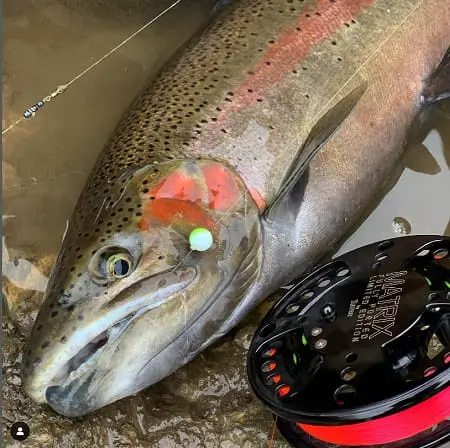
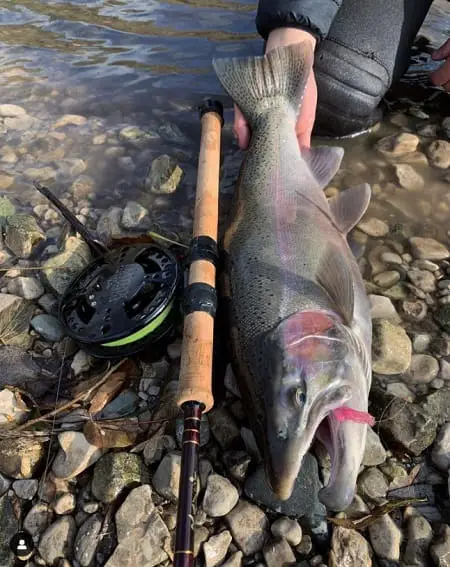
Thank you, an excellent overview and very thoughtful.
In England this method is known as ‘trotting’ and used for most river fish, grayling, roach, barbel. The carp anglers don’t use it that much as they mostly fish static baits in the pools and lakes.
We used to fish centerpins for carp in S. Africa, taking the spool off and casting it like a fixed spool reel. The larger diameter of the centerpin spool is effective for long casts. Also as you note when the fish picks up the bait the centerpin will let them take line and not feel any drag. I’ve had carp make a first run over 100 yards .. used to get little burns on the heel of the hand on a good day.
I prefer centerpins when possible, just as I prefer click/pawl fly reels to reels with drags.